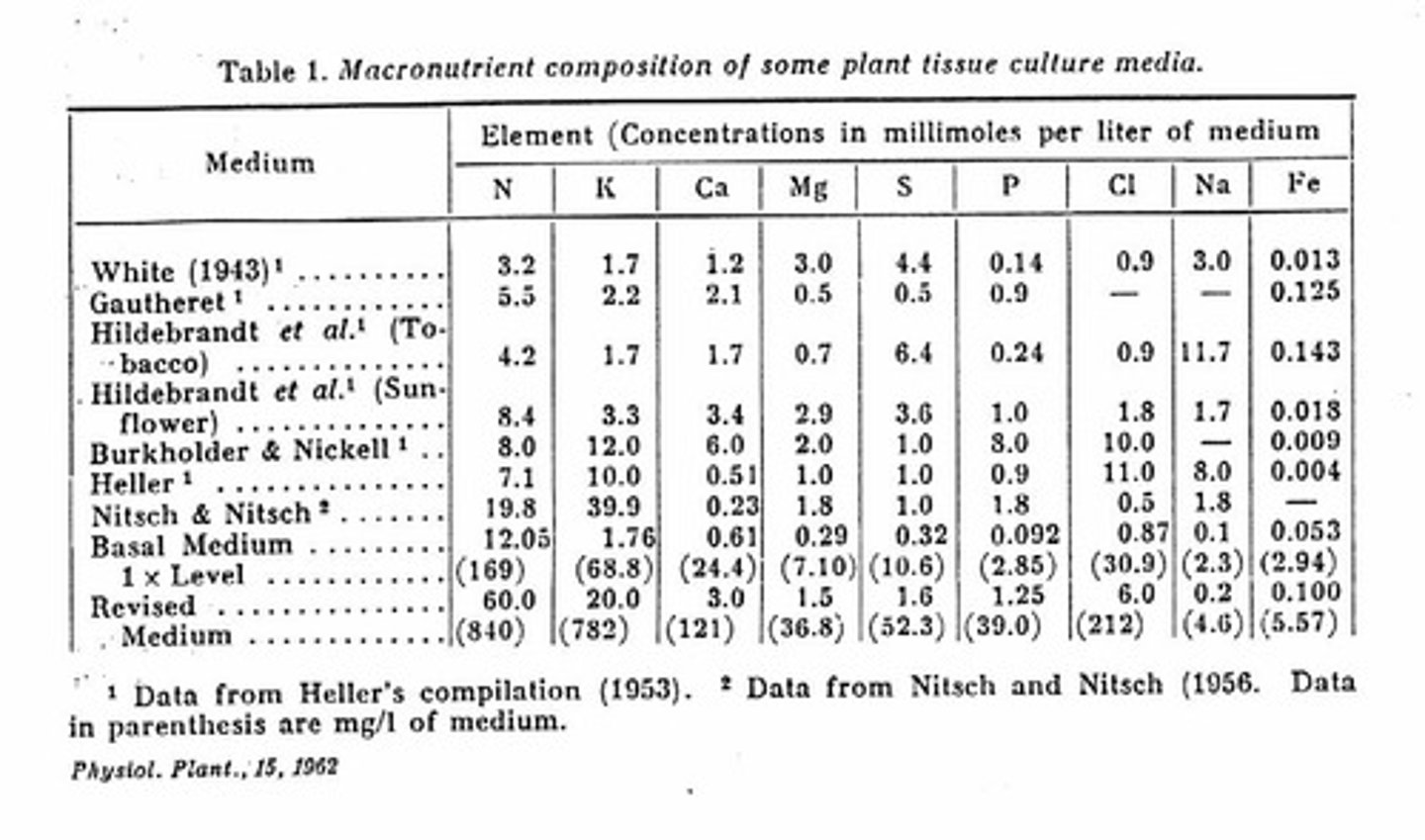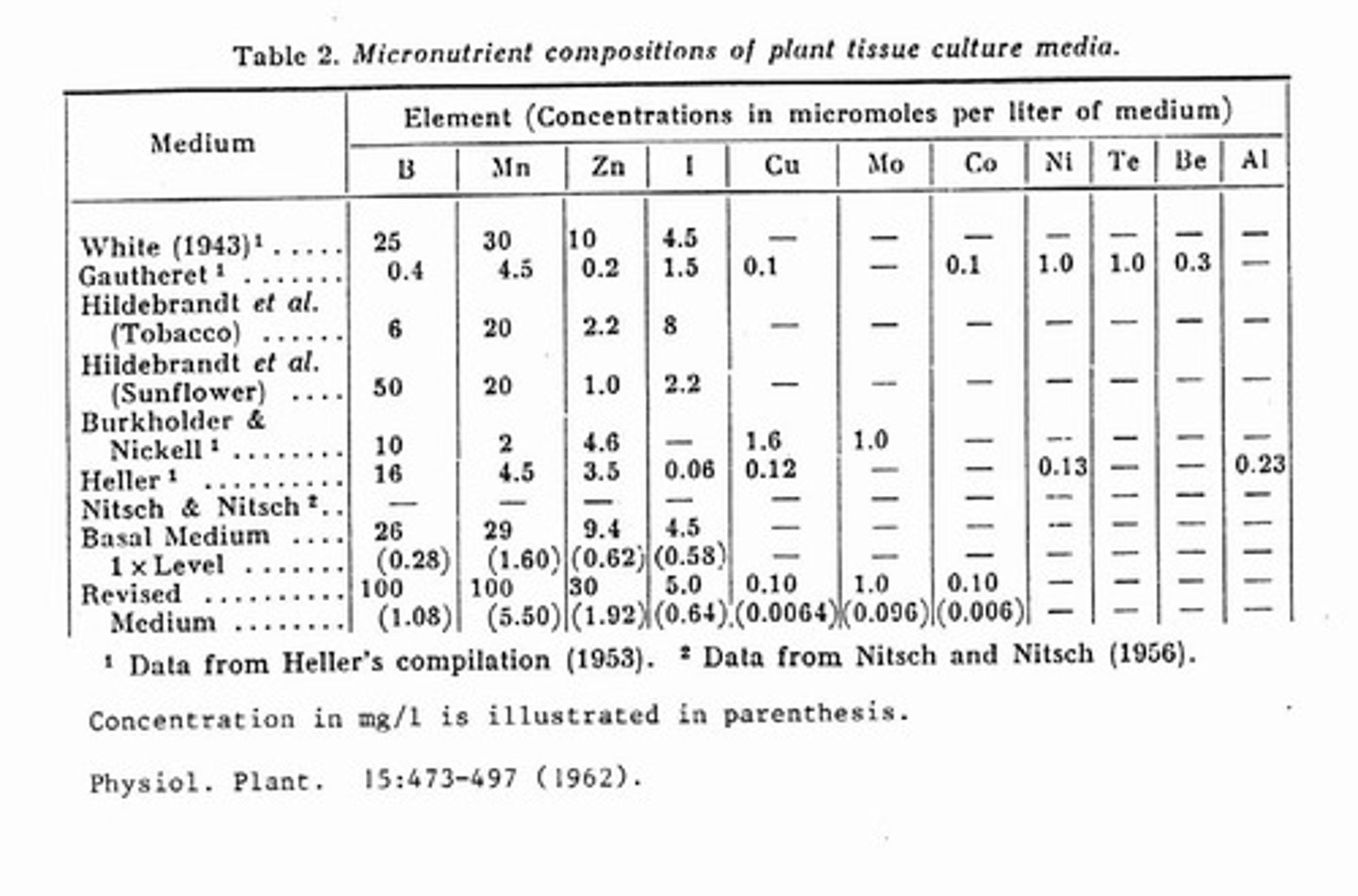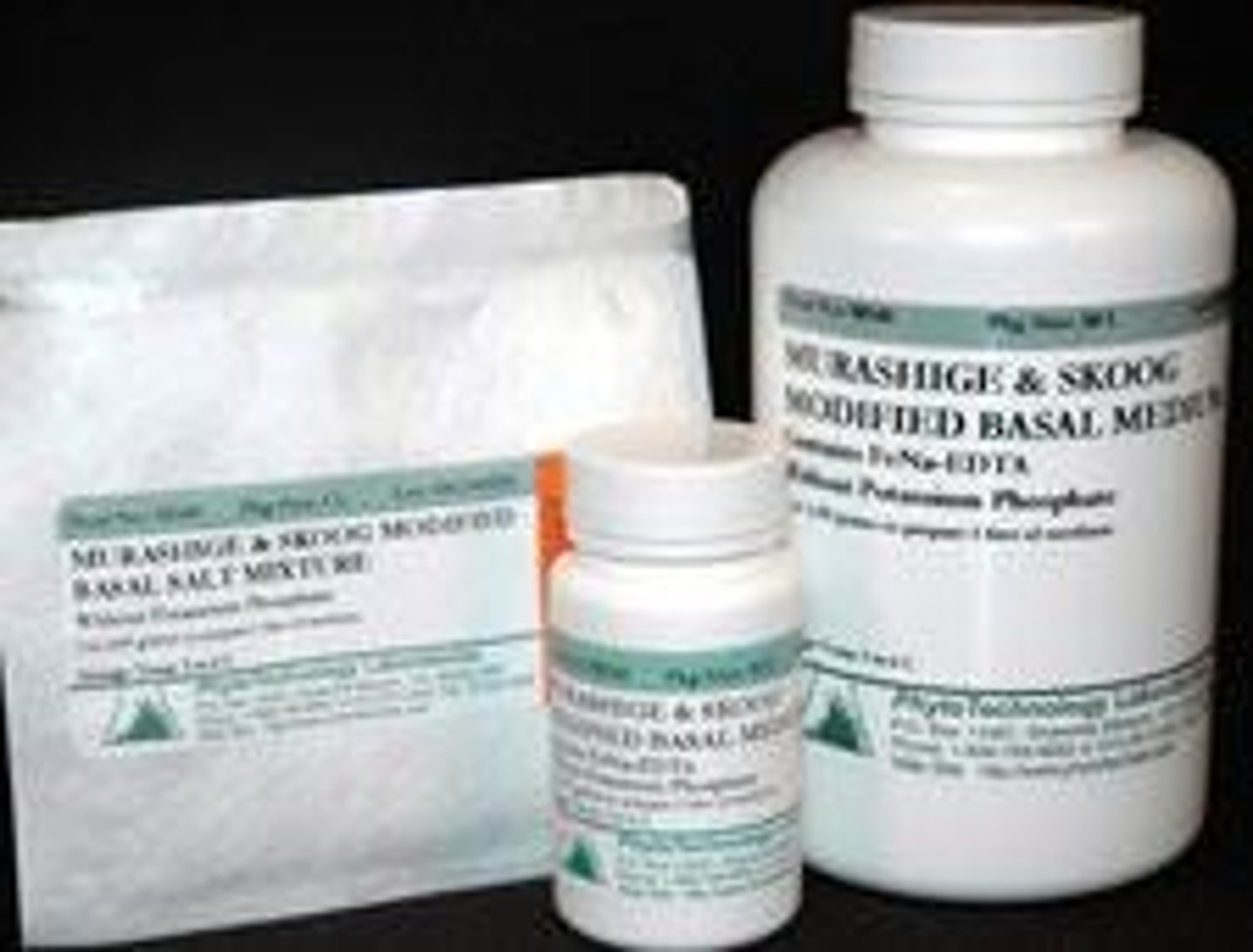Plant and Animal Cell Culture Media and Techniques
1/217
There's no tags or description
Looks like no tags are added yet.
Name | Mastery | Learn | Test | Matching | Spaced |
|---|
No study sessions yet.
218 Terms
Local Bases
The foundational components used in plant cell and tissue culture.
Culture Media
Substances that provide the necessary nutrients and environment for plant cell and tissue growth.
Hormones or Plant Regulators Growth (PGRs)
Chemical substances that influence the growth and development of plants.
Plant Culture Types
Different methods or systems used for culturing plant cells and tissues.
Essential Elements
Nutrients required for healthy plant growth, which must be present in adequate amounts.
Macronutrients
Relatively large amounts of inorganic elements necessary for plant nutrition, including Nitrogen, Calcium, Potassium, Phosphorus, Magnesium, and Sulphur.

Micronutrients
Small quantities of other elements required for plant nutrition, such as Iron, Chlorine, Zinc, Copper, Manganese, Boron, Molybdenum, Sodium, and Nickel.

Functions of the Medium
Roles of the culture medium including providing water, minerals, vitamins, growth regulators, amino acids, sugars, gas exchange, and waste removal.
Vitamins
Organic compounds generally incorporated into plant tissue culture media to support growth.
Amino Acids
Organic compounds that serve as the building blocks of proteins, sometimes included in plant tissue culture media.
Sugar
Carbohydrates added to plant tissue culture media, usually included except for specific purposes.
Undefined Supplements
Additives that contribute various components and plant growth substances to the culture medium.
Buffers
Substances that help maintain pH balance in culture media, recently suggested to be beneficial.
Solidifying Agent
A substance used to create a semi-solid medium in plant tissue culture.
Nitrogen
An essential macronutrient for plant life that influences growth and morphogenesis.
Phosphorus
A macronutrient absorbed as phosphate ions, important for plant growth.
Sulphur
A macronutrient absorbed as sulphate ions, necessary for plant health.
Quantity of the Macronutrient
The correct concentration and balance of macronutrient ions in plant tissue culture media.
Ammonium Ions
A form of nitrogen that plants can absorb, usually present in lower amounts compared to nitrate.
Nitrate Ions
A form of nitrogen that is predominantly found in most plant tissue culture media.
Nitrate
Has to be reduced to ammonium before being utilized biosynthetically.
Ammonium
In high concentration is latent toxic.
Nitrate in culture
Needs to be presented together with the reduced form of nitrogen; tissue will usually fail to grow on a medium with nitrate as the only nitrogen source.
Early 20th century uncertainty
Uncertainty still existed over the nature of the essential microelements.
Impure chemicals
Many tissue undoubtedly grown successfully because they were cultured on media prepared from impure chemicals or solidified with agar which acted as a micronutrient source.
Micronutrient evaluation
The advantage of adding micronutrients was mainly evaluated by their capability to improve the callus growth or root culture.
Knudson (1922)
Incorporated Fe and Mn on very successful orchid seed media.
Heller (1953)
First well demonstrated the advantages of microelements on tissue culture media.
Quantity of Micronutrient
Refers to the amount of micronutrient present in the culture medium.
MS medium
Formulated from the ash content of tobacco callus; higher concentration of salts substantially enhanced cell division.

Amino acids in culture media
Can be added to satisfy the requirement for reduced nitrogen, but are expensive to purchase.
Casein hydrolysate and yeast extract
Mainly consist of a mixture of amino acids that substantially increased the yield of callus.
Organic supplements
Have been especially beneficial for growth or morphogenesis when cells were cultured on media which do not contain ammonium ions.
Glycine
An ingredient of many media; helps to protect cell membranes from osmotic and temperature stress.
Common sources of organic nitrogen
Amino acid mixtures are the most common sources used in culture media.
Uptake of amino acids
More rapid than in organic amino acids (e.g., casein hydrolysate, L-glutamine, L-asparagine, and adenine).
Amino acids alone
When added alone, they can be inhibitory to cell growth.
Beneficial effects of amino acids
Rapid growth, Protoplast cell division, Conservation of ATP, AS chelating agent, Enhanced nitrogen assimilation, Not toxic as ammonium, As buffer.
Chelating agents
Some organic compounds are capable of forming complexes with metal cations, in which the metal is held with fairly tight chemical bonds.
Naturally occurring chelating agents
Naturally-occurring compounds can act as chelating agents such as proteins, peptides, carboxylic acids and amino acids.
Synthetic chelating agents
There are also synthetic chelating agents with high avidity for divalent and trivalent ions.
EDTA
Ethylenediamine tetra acetic acid.
EGTA
Ethyleneglycol-bis(2-aminoethylether) tetra acetic acid.
EDDHA
Ethylenediamine-di(o-hydroxyphenyl) acetic acid.
DTPA
Diethylenetriaminepentaacetic acid.
DHPTA
1,3 diamino-2-hydroxypropane-tetra acetic acid.
Iron properties
A key property of iron is its capacity to be oxidized easily from the ferrous (Fe(II)) to the ferric (Fe(III)) state and for ferric compounds to be readily reduced back to the ferrous form.
Iron usage in plants
Iron is primarily used in the chloroplasts, mitochondria and peroxisomes for effecting oxidation/reduction reaction.
Iron in photosynthesis
It is a component of ferredoxin proteins which function as electron carriers in photosynthesis.
Iron as micronutrient
Iron is an essential micronutrient for plant tissue culture and can be taken up as either ferrous (Fe2+) or ferric (Fe3+) ions.
Iron availability
Iron may not be available to plant cells, unless the pH falls sufficiently to bring free ions back to solutions.
Iron chelation
Iron can be chelated with EDTA.
Fe-EDTA chelate
The addition of Fe-EDTA chelate greatly improved the availability of the element.
Carbon source in plant tissue culture
Most plant tissue cultures are not highly autotrophic due to limitation of CO2.
Sugar in culture media
Sugar is added to the medium as an energy source.
Common sugars used
Sucrose is the most common sugar added, although glucose, fructose, mannitol, maltose and sorbitol are also used in certain instances.
Sugar concentration in media
The concentration of sugars in nutrient media generally ranges from 20 to 40 g/l.
Osmotic potential
Sugars contribute to the osmotic potential in the culture.
Sucrose inhibition
The presence of sucrose specifically inhibits chlorophyll formation and photosynthesis, making autotrophic growth less feasible.
Sucrose hydrolysis
Sucrose in the culture media is usually hydrolyzed totally or partially into the component monosaccharides glucose and fructose.
Sucrose superiority
The general superiority of sucrose over glucose may be on account of the more effective translocation of sucrose to apical meristems.
Thiamine (Vitamin B1)
Essential for most plant cultures, required for carbohydrate metabolism and the biosynthesis of some amino acids.
Pantothenic acid (Vitamin B5)
Essential as a coenzyme in the citric acid cycle.
Nicotinic acid (niacin)
A vitamin that is part of the B complex.
Pyridoxine (Vitamin B6)
A vitamin that is part of the B complex.
Myo-inositol
Although it is not essential for growth of many plant species, its effect on growth is significant; part of the B complex, in phosphate form is part of cell membranes and organelles.
Complex organics
Includes substances such as coconut milk, coconut water, yeast extract, fruit juices, and fruit pulps.
Gelling agents
Used when semi-solid or solid culture media are required; examples include agar, agarose, gelrite, and phytagel.
Structural supports
Includes filter paper bridges and liquid permeable membrane support systems.
Agar
The most commonly used gelling agent, a natural product extracted from species of red algae, especially Gelidium amansii.
Agarose
An alternating D-galactose and 3,6-anhydro-L-galactose with side chains of 6-methyl-D-galactose residues (50 -90%).
Agaropectin
Similar to agarose but additionally contains sulfate ester side chains and D-glucuronic acid.
Agar tertiary structure
A double helix with a central cavity that can accommodate water molecules.
Agar advantages
Inert component that forms a gel in water, melts at 100°C, and solidifies at nearly 45°C; concentrations commonly used in plant culture media range between 0.5% and 1%.
Agar disadvantages
Does not gel well under acidic conditions (pH <4.5) and may be inhibited by the inclusion of activated charcoal.
Agarose extraction
Extracted from agar leaving behind agaropectin and its sulfate groups; used when impurities of agar are a major disadvantage.
Gelrite
A polysaccharide produced by the bacterium Pseudomonas elodea, gives clear-solidified medium that leads to detection of contamination at an early stage.
Gelrite requirements
Requires more stirring than agar.
Concentration of divalent cations
Must be within the range of 4-8 mM/L or the medium will not solidify.
Phytagel
An agar substitute produced from a bacterial substrate composed of glucuronic acid, rhamnose and glucose.
Phytagel characteristics
Produces a clear, colorless, high-strength gel, which aids in detection of microbial contamination.
Phytagel usage
Used at a concentration of 1.5-2.5 g/L and should be prepared with rapid stirring to prevent clumping.
Murashige and Skoog (MS)
A type of commercial media formulation used in plant tissue culture.
Linsmaier and Skoog (LS)
A type of commercial media formulation used in plant tissue culture.
White Medium
A type of commercial media formulation used in plant tissue culture.
Gamborg medium
A type of commercial media formulation used in plant tissue culture.
Schenk and Hildebrandt medium
A type of commercial media formulation used in plant tissue culture.
Nitsch and Nitsch Medium
A type of commercial media formulation used in plant tissue culture.
Lloyd and McCown Woody plant medium
A type of commercial media formulation used in plant tissue culture.
Knudson's medium
A type of commercial media formulation used in plant tissue culture.
Hormone or Plant Growth Regulators (PGRs)
Small organic molecules that elicit a physiological response at very low concentrations.
Plant hormones
Chemical signals that coordinate different parts of the organism.
Regulation of growth
Internal and external signals that regulate growth are mediated, at least in part, by growth-regulating substances, or hormones.
Characteristics of plant hormones
They can be synthesized by plants, show specific activity at very low concentrations, and display multiple functions in plants.
Plant hormone interactions
Plant hormones may interact, either synergistically or antagonistically, to produce a particular effect.
Auxin
A type of plant hormone that is absolutely essential and promotes rooting, stimulates cell elongation, and mediates responses to gravity or light.
Natural compound of Auxin
Indole-3-acetic acid.
Synthetic analogues of Auxin
NAA, IBA, 2,4-D, 2,4,5-T, Picloram.
Cytokinins
A type of plant hormone that is absolutely essential and includes natural compounds like Zeatin and 2-isopentyl adenine.
Synthetic analogues of Cytokinins
Benzyladenine (BA or BAP), Kinetin.